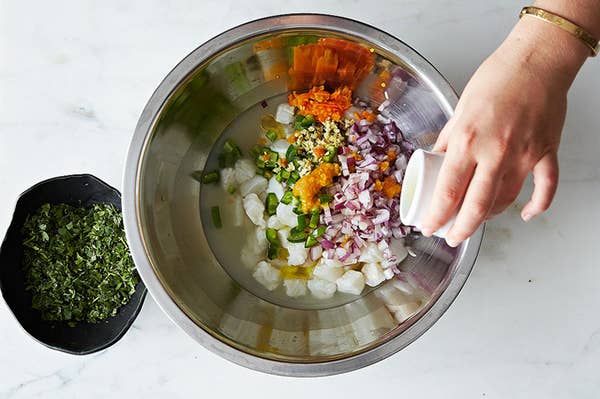
Weekend Reading: Systematic Ceviche, the History of Sour Beer, and More
What we’re reading, cooking, and clicking this week
Ceviche is what I cook—or, rather, don't cook—when it's hot as blazes outside (and in my kitchen). I've used the same ceviche recipe for years, but this Food52 article by Susan Feniger and Mary Sue Milliken [pictured] gives me the confidence to shake things up. Feniger and Milliken lay out a "ceviche formula" to guide you through making your own semi-raw creations: sustainable fish + fresh vegetables for crunch and texture + heat from a chile pepper + herbs, all bathed in an acidic juice; and, of course, a crunchy chip for garnish. The individual ingredient decisions are up to you. —Riddley Schirm
I loved the New Yorker's "A Brief History of Sour Beer" by Christian Debenedetti, which charts this brewing style's many pleasures and perils: "With pH akin to good Pinot Noir, the best make it onto serious menus. The worst taste of nail-polish remover, rotten apple, coconut, or the dreaded 'baby diaper.'" —Karen Shimizu
I loved Oliver Bullough's beautifully written essay for Roads and Kingdoms about the oyster growers working on England's muddy eastern coast. The British oyster industry fed the Romans and later the Victorians, but has since shrunk by about 99 percent. Additionally, the population of native Colchester oysters is now extremely small due to officials' decision to ramp up oyster production in the 1970s by introducing Pacific Rock Oysters, which turned out to be pretty invasive. But hey, it's not all bad news! Persistent fishermen are working with environmentalists to protect what's left. —Tejal Rao
Just what can't ratatouille do? "With a little imagination, a pot of ratatouille can be a door opening onto a whole world of dishes," says Thomas Keller, riffing poetically on the vegetable stew in the L.A. Times. Put it in the blender and transform it into a chunky puree for sandwiches. Blend it even more, until it becomes a silky-smooth base for vegetable soups. Toss it with mozzarella and put it over pasta. What a lovely new, ratatouille-filled world. —Sophie Brickman
There's so much more to a restaurant's identity than its food. After a devastating fire in March, Alice Waters has reopened a completely renovated Chez Panisse—and she takes Eater.com on a tour of the new space (and the process of building it) that's beautiful, informative, and fascinating. It's an engaging reminder to think about restaurants as physical objects that are the product of a great deal of thought and planning, not just rooms where you can eat lunch. —Helen Rosner
Louis Armstrong helped invent jazz, Henry Ford the automobile. And when it comes to Brooklyn's now-legendary dining scene, Andrew Tarlow may go down as the guy who brought homemade mayo, in-house butchery and, well, the entire farm-to-table phenomenon to the once-maligned burough. Raquel Pelzel's portrait of Tarlow in the latest issue of Edible Brooklyn explains how. —Keith Pandolfi
I found out via Grub Street that TV's newest cooking competition series will feature children as wannabe chefs. I figured it must be a joke as I eagerly clicked to watch the trailer for the show. As the children screamed at each other and ran around the kitchen with hot saute pans and flames a-blazin', I found my face frozen, caught between an expression of horror and a laugh. I wonder if the winner earns a get-out-of-high-school-free card. —Felicia Campbell
I look forward each year to the results of National Geographic's Travel Photo Contest, and 2013's winners don't disappoint: From an action-packed, droplet-spattered black and white photo of an aquathlon in Brazil; to a multi-layered, purple-drenched shot of a dramatic thunderstorm in a Utah canyon, these photos are visually arresting reminders of the stunning diversity of our natural—and human—world. —Lauren Rothman
I've recently been watching "All You Can Eat" on the History Channel's website. Hosted by comedian John Pinette, this series tells the story of "how what we eat ends up in our mouths." My favorite episode is about stuffed foods: From turkeys to potatoes, and pork stuffed with pork wrapped in pork, it's a fun way to learn about food techniques and cuisine. The highlight? Mike Brown, of restaurant Travail in Minneapolis, stuffs chickens with lemons in a completely unexpected way. —Farideh Sadeghin
Keep Reading
Continue to Next Story










